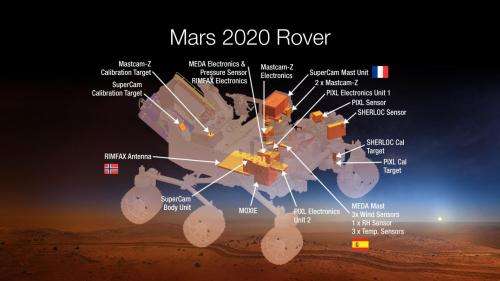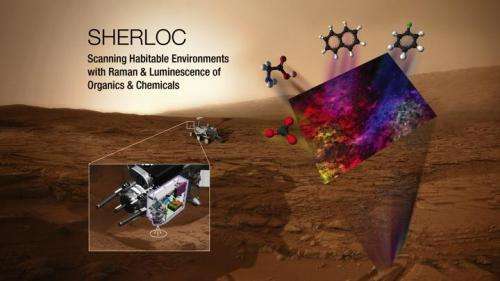SHERLOC to micro-map Mars minerals and carbon rings

(Phys.org) —An ultraviolet-light instrument on the robotic arm of NASA's Mars 2020 rover will use two types of ultraviolet-light spectroscopy, plus a versatile camera, to help meet the mission's ambitious goals, including a search for signs of past life on Mars and selection of rock samples for possible return to Earth.
It is called SHERLOC, for Scanning Habitable Environments with Raman & Luminescence for Organics and Chemicals.
"This instrument uses two distinct detection strategies," said its principal investigator, Luther Beegle of NASA's Jet Propulsion Laboratory in Pasadena, California. "It can detect an important class of carbon molecules with high sensitivity, and it also identifies minerals that provide information about ancient aqueous environments."
SHERLOC will shine a tiny dot of ultraviolet laser light at a target. This causes two different spectral phenomena to occur, which the instrument captures for analysis. The first is a distinctive fluorescence, or glow, from molecules that contain rings of carbon atoms. Such molecules may be clues to whether evidence of past life has been preserved. The second is an effect called Raman scattering, which can identify certain minerals, including ones formed from evaporation of salty water, and organic compounds. This dual use enables powerful analysis of many different compounds on the identical spot.
A moving mirror in the instrument will shift pointing of the ultraviolet laser beam in a scanning pattern to provide a map of the ingredients at a microscopic scale. The laser beam has a diameter of 50 microns—about half the thickness of a piece of paper. It will provide information on that scale within a target area about half the breadth of a dime.

In addition, the instrument will include a contextual camera utilizing hardware originally developed by Malin Space Science Systems, San Diego, for the Mars Hand Lens Imager (MAHLI) camera on NASA's Curiosity Mars rover. This context imager will enable researchers to correlate the composition information with visible features in the target, resulting in more information than composition alone.
Beegle said, "We'll be able not just to detect these chemicals and minerals with high sensitivity, but we will produce powerful chemical maps. For example, we can see whether organics are clumped together or diffuse, and we can correlate minerals with visible veins or grains in the rock. This also allows us to integrate our results with the other instruments for even more informational content on the samples."
NASA announced selection of SHERLOC and six other investigations for the Mars 2020 rover's payload on July 31, 2014.
The Mars 2020 mission will be based on the design of the highly successful Mars Science Laboratory rover, Curiosity, which landed almost two years ago, and currently is operating on Mars. The new rover will carry more sophisticated, upgraded hardware and new instruments to conduct geological assessments of the rover's landing site, determine the potential habitability of the environment, and directly search for signs of ancient Martian life.
Scientists will use the Mars 2020 rover to identify and select a collection of rock and soil samples that will be stored for potential return to Earth by a future mission. The Mars 2020 mission is responsive to the science objectives recommended by the National Research Council's 2011 Planetary Science Decadal Survey.
The Mars 2020 rover also will help advance our knowledge of how future human explorers could use natural resources available on the surface of the Red Planet. An ability to live off the Martian land would transform future exploration of the planet. Designers of future human expeditions can use this mission to understand the hazards posed by Martian dust and demonstrate technology to process carbon dioxide from the atmosphere to produce oxygen. These experiments will help engineers learn how to use Martian resources to produce oxygen for human respiration and potentially for use as an oxidizer for rocket fuel.
Provided by NASA



















